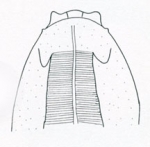NEIHPID
North-East India Helminth Parasite Information Database
Recently added
Parasites
Molecular Data
Setaria digitata (Railliet et Henry Railliet et Henry) Linstow 1906
Taxonomy
Nematoda »
SECERNENTEA »
Onchocercidae (Leiper, 1911) Anderson et Bain, 1976 »
Setariinae Yorke et Maplestone, 1926 »
Setaria Viborg, 1795 »
Setaria digitata (Linstow 1906), Railliet et Henry 1911
Host
Bos (indicus)
Habitat
Peritoneal cavity
Locality
Shillong (Meghalaya), Nongstoin (Meghalaya), Sohiong (Meghalaya), Mairang (Meghalaya), Markasa (Meghalaya), Jowai (Meghalaya)
Description
General
Body several centimeters long, milky white, tapering towards hind end, latter spirally coiled. Cuticle smooth, rather thick with fine transverse striations, without lateral alae. Mouth opening round, surrounded by raised dorso-ventrally elongate peri-buccal ring with notched dorsal and ventral prominences; processes notched at apex so as to give two more, or less prominent angular points. Cephalic papillae less prominent; four sub-median, four sub- lateral, two lateral papillae) all lying behind peri-buccal crown. Oesophagus divided into anterior short, thin muscular portion and posterior long, thick, glandular portions. Tail provided with pair of tiny lateral appendages near its end.
Male
Body 42.0-52.0 mm in length, 0.41-0.51 mm in maximum width. Posterior extremity attenuated, coiled spirally to ventral side, with pair of small lateral cuticular appendages near tip of tail. Caudal alae absent. Tail possessing four pairs of pre-anal, three pairs of post-anal papillae arranged in sub-ventral rows. Cuticle forming transverse folds, which expand laterally in front of pre-anal papillae on spiral part of body. Spicules very unequal, dissimilar, alate; left spicule longer, with tubular proximal portion, distal membranous portion extending to a cuticular blade; right spicule short, stout, somewhat boat shaped, slightly curved ventrally, with tip directed backwards.
Female
Body 72.0-96.0 mm in length, 0.45-0.57 mm in maximum width. Tail bent dorsally into loose spiral, terminating in spherical terminal bearing 1-2 circlets of spikes, pair of well-developed small rounded appendages just near its tip. Vulva projecting slightly above body surface lying in oesophageal region. Vagina highly muscular situated at level of union parts of oesophagus, forming 'S'-shaped structure, bifurcates into two uteri occupying large anterior part of body cavity; in sexually mature individuals part of uterus filled with microfilariae. Eggs thin shelled, containing coiled microfilaria.
Remarks
This species was originally described as Filaria digitata on the basis of nematodes obtained from Bos indicus in Sri Lanka, and in 1911 transferred to the genus Setaria by Railliet and Henry. Boulenger (1921) re-described the female of this species, indicating its morphological differences from the female of S. labiatopapillosa (Alessandrini, 1838). Schwartz (1926) and Thwaite (1927) also expressed the same view. However, Purvis (1931) and Baylis (1936b) considered S. digitata a synonym of S. labiatopapillosa. In the same year Baylis (1936b) synonymized it with S. cervi. Later on, other workers such as Sarwar (1946a) and Skrjabin and Shikhobaleva (1945) did not agreed with the opinions of Purvis and Baylis, and considered the species S. digitata an independent one. Yeh (1959), while revising the genus Setaria studied a collection of Setaria from cattle of various countries of Southeast Asia. He came across a co-infection of these animals by nematodes of the species S. labiatopapillosa and S. digitata which he reported to be quite different in morphology. The two species can be distinguished by the shape of the mouth opening - round (in S. digitata) against oval (in S. labiatopapillosa) and presence or absence of bosses on the tail of female. Shoho (1959) also pointed out that the two species are distinct and valid. Desset (1966) was also of the same view and pointed out that the absence of bosses on the caudal end in S. digitata or their presence in S. labiatopapillosa may be considered the only reliable difference listed by Yeh .The present species can also be differentiated from S. cervi, commonly reported from Bovidae in India, as the tail terminates in bell-shaped thickening and the cephalic crown appears with four odontoid cuticular outgrowths protracted in dorso-ventral direction in the latter species.
Except for the variation in the number of caudal papillae and the terminal knob of tail, which sometimes appeared simple, all other characters tally with the description provided by Yeh (1959); the latter author mentioned eight pairs of caudal papillae.
Helminthological collections record
NEHU/Z - NM/24
References
Railliet, A. and Henry, A. (1911). Sur une filaire peritoneale des porcins. Bulletin de la Societe de Pathologie Exoitque. 4:pp 386-389
Boulenger, C. L. (1921) On some filariid parasites of cattle and other ruminants.
Alessandrini, A. (1838) Observazioni antomiche intorno a diverse specie di entozoarii de genere Filaria. Nuovi Annali delle Science Naturali. 1:pp 1-17.
Thwaite, J. W. (1927). On a collection of nematodes from Ceylon. Annals of Tropical Medicine and Parasitology. London. 21:pp 225-244.
Purvis, G. B. (1931) Setaria labiato-papillosa (Alessandrini, 1938) or Setaria digitata (Von Linstow, 1906). Veterinary Record. 11:pp 528-529
Baylis, H. A. (1936b). On the nomenclature and synonymy of the nematode Setaria labiato-papillosa: Annals of Tropical Medicine and Parasitology. 30:pp 293-298.
Sarwar, A. M. (1946). Two species of the nematode genus Setaria Viborg. Indian Veterinary Journal. 22:pp 405-409.
Skrjabin, K .I. and Shikhobalova, N. P. (1945). A new rearrangement of the taxonomy of the nematodes belonging to the family Filariidae Cobbold, 1864. Doklady Akademii Nauk SSSR. 49: pp 690-692.
Yeh, L. S. (1959) A revision of the nematode genus Setaria Viborg, 1795, its host-parasite relationship speciation and evolution. Journal of Helminthology. 33:pp 1-98.
Shoho, C. (1959). Die Setarien vom Schweizerischen Reh, Capreolus capreolus. Revue Suisse de Zoologie. 66:pp 233-258.
Desset, M. C. (1966). Contribution a la systematique des filaires du genre Setaria, valeur des dierides. Memoires du Museum Natural d'Histoire Naturelle, Paris. 39:pp 257-286.



.jpg)
